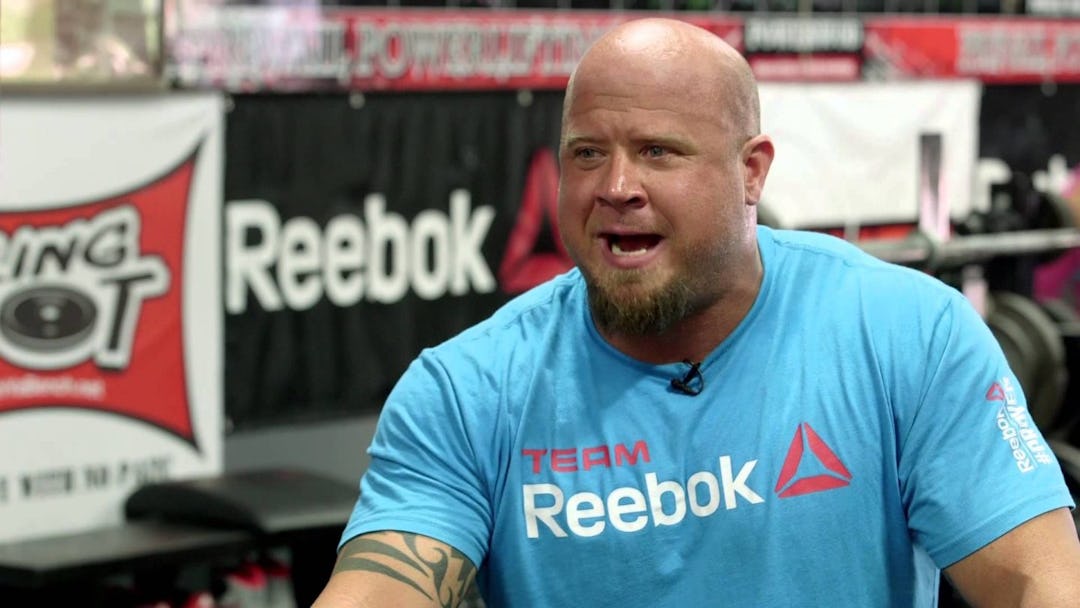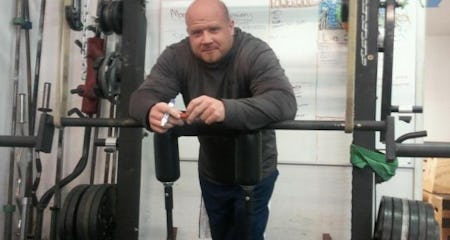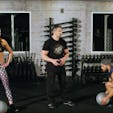As a powerlifter who’s totaled elite in five different weight classes, Jesse Burdick is sort of like the Ant Man of strength sports: he can blow up and shrink down at will. Burdick even competed in the 220-pound and super-heavyweight classes in the same year—about an 80-pound difference. His best raw lifts (without assistive equipment) include a 733-pound squat, 521 bench press, and 766 deadlift, and he now works with athletes as a strength and nutrition coach in Dublin, CA.
Get Lean, Not Weak: Q&A With Jesse Burdick
When Burdick visited Onnit recently, we tapped his brain for tips on getting strong, keeping muscle while dieting down, psyching up to set PR’s, and how to build a hardcore home gym on the cheap.
Onnit: Powerlifters, football players, and other strength athletes primarily use the max-effort method to get stronger. They choose a barbell lift and keep their reps low—1 to 5—and work up to a load that allows them only 1–3 reps. After one “top” set, they move on to other exercises. However, you’ve said that’s not enough work for most people to see gains. Can you explain how you modify this method for the rest of us?
Jesse Burdick: So many articles on the web about strength are based on what elite powerlifters do, and that may only be one top set, but what they don’t show you is all the sets they took to get to that main set. So, for most people, just aiming to do one heavy set isn’t enough.
For instance, a guy who deadlifts 600 pounds doesn’t just do a couple of knee bends and then load 600 on the bar. Here’s how he might work his way up to 600.
135 x 5 reps
185 x 5
225 x 5
275 x 3
315 x 3
365 x 3
405 x 2
455 x 1
495 x 1
545 x 1
600 x 1–3
By the time this deadlifter gets to 600, he’s already done 10 sets, and the last three or four used weights he finds challenging. That’s a lot of work. Contrast this to a guy who squats 315. His work-up sets may go as follows.
135 x 5
185 x 5
225 x 3
275 x 1
315 x 1–3
With only two or three “heavy” sets under his belt for the exercise, he can’t stimulate his nervous system to recruit the maximum number of muscle fibers needed to gain size and strength optimally. In other words, he needs to do more work with weights that are closer to his max in order to get bigger and stronger. Another mistake guys make is simply rushing up to their top set and skipping a lot of work-up sets because they want to save energy. They take bigger weight jumps than they should—more than 50 pounds, maybe—and, again, the total volume ends up being too low. Think of your main lift like doing a math problem in school: you have to show your work, or I’m not going to accept your answer.

So what do you recommend?
You can either do more warm-up sets or do more work on the back end. Instead of doing one top set and being done with it, I like to have people do 1–3 top sets of 1–5 reps and then back off to 80% of that load for another 1–2 sets of as many reps as possible. That 80% is kind of a magic number—it’s enough for the weight to be taken seriously but it’s not so much that your form breaks down. You’ll be able to get 8–12 reps with it, which trains good form and builds muscle.
How do you psyche yourself up to set a PR, or step up to a big lift that may scare the hell out of you?
There’s a video on YouTube of me preparing to squat 848 pounds in a meet, and a guy comes up and slaps me right in the face to help me “focus.” I slapped him back, pushed him across the room, lost focus, and missed the lift. You don’t need to get worked into a frenzy to lift heavy weights. It’s actually better to try and calm yourself down a bit. You want to feel excited but not nervous.

You’re renowned for your ability to gain and drop weight fast. What’s the secret?
The simplest way to make your body weight go up or down is to adjust the amount of carbs you’re eating. I eat more carbs when I want to put on muscle and fewer when I need to lose fat or go down a weight class. But you don’t have to break out a scale or calculator to keep track of your intake.
I just focus on getting my protein in and my carbs are wrapped around my workout. I’ll aim for a gram of protein per pound of body weight—sometimes more if I’ve already lost a lot of weight and want to get even leaner—and I restrict carbs to workout days only. If I’m dieting, a typical meal is to throw chicken breast over lettuce or spinach or some other green. If I’m gaining, I throw the same chicken over rice.
I have clients that have a lot of weight to lose start with a very low-carb diet the first few weeks. Depending on how they do, I’ll add carbs in as needed, starting before the workout to boost energy for training. I’ll start people on 20–30 grams carbs before the workout. If they say, “I felt awesome on my main lift, but then I ran out of energy on my accessory exercises,” I give them another dose of carbs during their workout. If they tell me they crashed after the workout, I give them more carbs then too.
Carbs can come in the form of a powdered drink mix, rice, or even some store-bought junk like granola bars. All we’re trying to do is give them fuel for the workout and recovery. Oatmeal would be great, but the reality is that most people are going to grab a sports drink or something else that’s easy, and I don’t have a problem with that.
How do we keep strength while dieting?
There’s an expression that a man who chases two rabbits goes home hungry. If you try to chase big numbers in the gym while dieting to get abs, you’re going to end up weak and/or fat. Pick one goal and that’s your priority. You have to accept that you’re going to lose some strength when you diet and you’ll gain some fat when you’re bulking up.
People take for granted what weight loss does to their body. A 10-pound drop on the scale can mean the loss of a quarter-inch to an inch on certain body parts, and that changes the leverages of your lifts. Don’t be surprised if you’re squatting one day and suddenly feel like you can’t push yourself up out of the hole. Weight loss can have you operating with a completely different machine.
You can preserve strength as much as possible by making sure your form on lifts is as tight as it can be. Good form means efficient movement, which translates to greater force production. You can also shorten your workouts to put less demand on your ability to recover. When I diet, I’ll cut down from 90-minute sessions to 45 minutes to an hour. That forces me to maximize the time I’m in the gym.
Instead of trying to lift your heaviest and getting disappointed, do more sets with 70–80% of your max loads. Sets of 6–12 reps are still heavy enough to maintain muscle and strength, but aren’t as taxing on the system and carry a lower risk for injury. You just have to be OK with treading water for a while until you hit your body comp goal, so be realistic about what you can do and take it a piece at a time.

You’re a believer in using supplements to support a diet. What has your experience been with Onnit products?
I absolutely love Alpha BRAIN®.
You haven’t always trained in hardcore gyms. In fact, you’re living proof that a person can get jacked and build world-class strength at home. What tips can you offer for setting up a home gym?
Go on Craigslist and look at who’s selling fitness equipment. People who are offering benches, bars, plates, and dumbbells are typically desperate to get rid of them. They don’t want heavy, bulky iron cluttering up their houses anymore, and you’ll be amazed at how far they’re willing to go to unload them.
The trick is to be an asshole. Any time I see a post around the holidays, or read that someone is moving, I automatically take 50% off of whatever price they asked for and tell them to deliver it to me for free. I say, “I’ve got cash in hand and I’ll take it today.” Ultimately, you’re doing them a favor. His wife wants that old weight set she’s been tripping on out of their garage—yesterday. And, honestly, he probably marked up its true value when he posted it anyway.
Weight plates usually cost $1.50 to $2 a pound, but I’ve gotten 10 45-pound plates—450 pounds—for $200 by arguing on Craigslist. You’ll never get that deal anywhere else.
Visit Burdick at powerwod.com.

)






